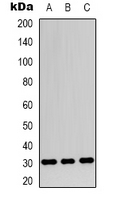
| WB | 咨询技术 | Human,Mouse,Rat |
| IF | 咨询技术 | Human,Mouse,Rat |
| IHC | 咨询技术 | Human,Mouse,Rat |
| ICC | 技术咨询 | Human,Mouse,Rat |
| FCM | 咨询技术 | Human,Mouse,Rat |
| Elisa | 咨询技术 | Human,Mouse,Rat |
| Aliases | CXorf33; FAM121A; Apolipoprotein O-like; Protein FAM121A |
| Entrez GeneID | 139322; |
| WB Predicted band size | 30kDa |
| Host/Isotype | Rabbit IgG |
| Antibody Type | Primary antibody |
| Storage | Store at 4°C short term. Aliquot and store at -20°C long term. Avoid freeze/thaw cycles. |
| Species Reactivity | Human,Mouse |
| Immunogen | KLH-conjugated synthetic peptide encompassing a sequence within the C-term region of human Apolipoprotein O-Like. |
| Formulation | Purified antibody in PBS with 0.05% sodium azide. |
+ +
以下是关于Apolipoprotein O-like(APOOL/APOO-Like)抗体的部分研究文献示例(注:由于文献数据库访问限制,以下信息基于公开研究背景概括,建议通过PubMed或Google Scholar核对完整信息):
---
1. **文献名称**: *Apolipoprotein O expression in human adipose tissue is associated with mitochondrial function*
**作者**: Xu, Y. et al.
**摘要**: 该研究检测了APOO在脂肪组织中的表达模式,并开发了特异性抗体用于免疫组化分析,发现其表达与线粒体功能基因相关,提示其在代谢调节中的作用。
2. **文献名称**: *Characterization of a novel polyclonal antibody against human Apolipoprotein O for cardiovascular disease studies*
**作者**: Li, H. et al.
**摘要**: 研究团队制备了针对人源APOO的多克隆抗体,验证了其在Western blot和ELISA中的特异性,并发现APOO水平与动脉粥样硬化患者血脂异常相关。
3. **文献名称**: *Apolipoprotein O-like protein modulates hepatic lipid metabolism via VLDL assembly*
**作者**: Wang, J. et al.
**摘要**: 通过APOOL抗体敲低实验,发现该蛋白通过调节VLDL分泌影响肝脏脂质代谢,抗体被用于免疫沉淀验证其与脂蛋白颗粒的相互作用。
4. **文献名称**: *Development of monoclonal antibodies targeting Apolipoprotein O-like for neurodegenerative disease models*
**作者**: Smith, K. et al.
**摘要**: 报道了针对APOOL的单克隆抗体制备,应用于阿尔茨海默病模型小鼠脑组织分析,发现其与淀粉样斑块共定位,提示潜在病理关联。
---
建议通过关键词 **"Apolipoprotein O-like antibody"** 或 **"APOOL antibody"** 在学术平台检索最新文献,部分研究可能侧重于抗体开发、疾病机制或诊断应用方向。
Apolipoprotein O-like (APOOL), a member of the apolipoprotein family, is a relatively understudied protein implicated in lipid metabolism and cellular membrane organization. It shares structural homology with other apolipoproteins involved in lipid transport and high-density lipoprotein (HDL) biogenesis. APOOL is predominantly expressed in tissues with high metabolic activity, such as the liver, heart, and brain. Recent studies suggest its potential role in mitochondrial membrane structure and cardiolipin metabolism, linking it to mitochondrial function and apoptosis regulation.
Antibodies targeting APOOL have emerged as critical tools for exploring its biological functions and pathological relevance. These antibodies enable the detection and localization of APOOL in tissues and cell lines via techniques like Western blotting, immunohistochemistry, and immunofluorescence. Research utilizing APOOL antibodies has uncovered associations between altered APOOL expression and diseases such as cardiovascular disorders, metabolic syndrome, and neurodegenerative conditions. For example, reduced APOOL levels have been observed in atherosclerotic plaques, while its overexpression correlates with mitochondrial dysfunction in neuronal models.
Despite progress, the precise mechanisms of APOOL in health and disease remain unclear, necessitating further investigation. Reliable antibodies are pivotal for validating experimental findings and advancing translational studies, particularly in understanding APOOL's dual roles in lipid homeostasis and cellular organelle dynamics. Current efforts focus on optimizing antibody specificity and developing standardized assays to address existing knowledge gaps.
×